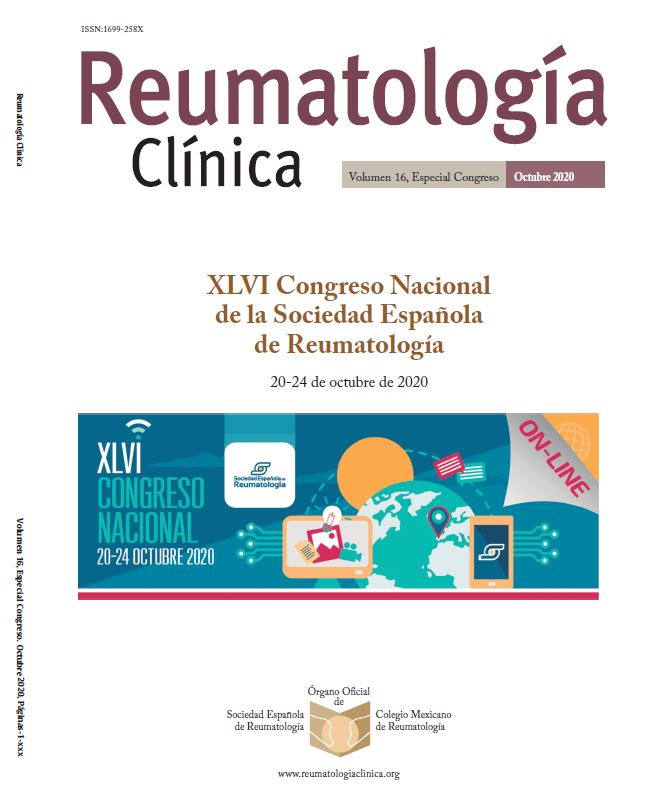RC006 - Baricitinib use and effectiveness in patients with Rheumatoid Arthritis (RA) in usual clinical practice: ORBIT observational study
1Hospital Universitario Virgen Macarena. Sevilla. 2Hospital Marina Baixa. Alicante. 3Hospital de la Santa Creu i Sant Pau. Barcelona. 4Hospital Universitario Donostia. 5Hospital Universitario La Princesa. Madrid. 6Hospital Clínic. Barcelona. 7Medical Department. Lilly. Madrid.
Introduction: Baricitinib (BARI) is an oral Janus kinase (JAK)1/JAK2 inhibitor approved to treat moderately to severely active rheumatoid arthritis (RA). There is limited data available about its effectiveness in daily clinical practice. The ORBIT study was designed to investigate patients’ profile, treatment patterns, effectiveness and persistence, in patients with RA receiving BARI in real-world setting in Spain.
Methods: A multicenter retrospective observational study on adult RA patients starting BARI between 30th September 2017 and 31st May 2019 was carried out in 5 Rheumatology Units. Patients ≥ 18 years, with diagnosis of RA (ACR 2010 criteria), treated with BARI (current or past), with available medical record were included. Demographic, laboratory values (C-reactive protein, erythrocyte sedimentation rate (ESR)), disease activity (DAS28-ESR, SDAI, CDAI, EULAR response criteria) and VAS patient´s pain assessment 0-10 mm) were collected prior BARI initiation (baseline) and after 6 and 12 months. Continuous data were presented as mean (SD), and categorical variables as frequency with percentage. Effectiveness data was evaluated by changes from baseline in effectiveness variables using paired t-test. BARI persistence was calculated as the percentage of patients who maintained treatment with baricitinib during 6/12/18 months.
Results: 182 RA patients were included. 83.5% women, age 62.2 (12.3) years, BMI 26.8 (5.1), 47.8% non-smokers. At BARI initiation, disease duration was 13.2 (10.8) years, 79.1% of patients had positive RF, 80.2% positive ACPA and 64.8% bone erosions; Charlson Comorbility Index score was 2.4 (1.9). Patients had received prior treatment to BARI 1, 2, ≥ 3 drugs: 11.0%, 36.8% and 52.2% for conventional DMARDS (cDMARDs); 28.0%, 23.6% and 14.3% for TNF-inhibitors (TNFi) biologic DMARDs (bDMARDs); 29.7%, 18.1% and 8.8% for non-TNFi bDMARDs; and 76.4% corticosteroids. 90.1% started with BARI 4 mg/day; 17.6% in monotherapy and 56.6% combined with cDMARDS (37.4% with methotrexate). The previous treatment was stopped by inefficacy to cDMARDS in 22.2% and to bDMARDS in 77.8%. Overall, 71.6% and 76.3% achieved remission or low activity assessed by any disease activity index after 6 and 12 months: DAS28-ESR (73.1% and 73.5%), SDAI (62.4% and 75.0%) and CDAI (63.5% and 76.6%), after 6 and 12 months respectively; 80.0% and 78.2% of patients had good or moderate EULAR response after 6 and 12 months respectively. Pain decreased from a mean (SD) score of 6.6 (2) at baseline to 4.1 (2.5) at 6 months (N = 93) and from baseline score of 6.5 (2.2) to 3.4 (2.2) at 12 months (N = 75). Persistence rate at 6/12/18 months was 79.7%/64.8%/59.1%. At the time when the cohort was built, 61.5% of patients continued treatment with BARI; mean time on treatment was 14.1 (0.5) months. Main BARI discontinuation reasons: 68.6% (n = 48/182) lack of effectiveness (60.4% primary failure, 39.6% secondary failure) and 18.6% (n = 13/182) adverse reaction.
|
Changes between baseline and 6 months |
Changes between baseline and 12 months |
|||||
|
Variable (Change from Baseline) |
N available |
Score prior BARI start |
After 6 months with BARI |
N available |
Score prior BARI start |
After 6 months with BARI |
|
DAS28-ESR* |
75 |
4.3 (1.1) |
-1.7 (1.4) |
46 |
4.2 (1.0) |
-1.7 (1.5) |
|
SDAI* |
91 |
24.3 (10.1) |
-13.4 (11.6) |
62 |
23.3 (10.3) |
-14.4 (12.0) |
|
CDAI* |
91 |
23.0 (10.0) |
-13.0 (11.4) |
62 |
21.9 (10.4) |
-13.7 (11.8) |
|
Patient’s pain assessment* |
93 |
6.6 (2.0) |
-2.5 (2.6) |
75 |
6.5 (2.2) |
-3.0 (2.4) |
|
*Mean (SD); DAS28-ESR (Disease Activity Score Erythrocyte Sedimentation Rate); SDAI (Simplified Disease Activity Index); CDAI (Clinical Disease Activity Index). Patient´s pain assessment measured with a Visual Analogue Scale (VAS) that ranges from `0’ (no pain) to `10’ (highest pain). Change calculation used the n available in each cut-points. |
||||||
Conclusions: In Spain patients undergoing BARI treatment had a long-standing and refractory disease. Nevertheless, high persistence rates across time and major improvements in disease activity have been seen at 6 and 12 months of treatment independently of the articular index used, confirming the effectiveness of BARI in real life setting.






